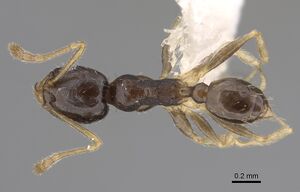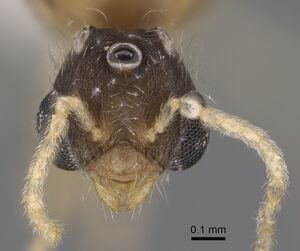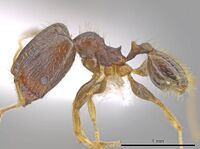Pheidole depressinoda
| Pheidole depressinoda | |
|---|---|

| |
| Scientific classification | |
| Kingdom: | Animalia |
| Phylum: | Arthropoda |
| Class: | Insecta |
| Order: | Hymenoptera |
| Family: | Formicidae |
| Subfamily: | Myrmicinae |
| Tribe: | Attini |
| Genus: | Pheidole |
| Species: | P. depressinoda |
| Binomial name | |
| Pheidole depressinoda Longino, 2019 | |
This species is known from one site, a reserve with somewhat seasonal moist forest. Minor and major workers recruit to ground baits. Workers occur in Winkler samples of sifted litter and rotten wood. A nest was discovered by following workers from a bait to a soft rotten stick in the litter.
Identification
Longino (2019) - Minor: face largely smooth and shining, with foveolate sculpture between eye and antennal fossa, very faint traces of foveolate sculpture elsewhere; promesonotal groove absent; side of mesosoma and dorsal face of propodeum foveolate (side of pronotum with variable presence of a smooth patch), promesonotal dorsum smooth and shiny; propodeal spines about one third length of posterior face of propodeum; postpetiole longer and broader than petiolar node, but dorsoventrally depressed, lower than petiolar node in profile (typical postpetiolar shape of P. punctatissima and relatives); gaster mostly smooth and shining, with very small area of shagreening near postpetiolar insertion; face, mesosoma, and gaster with short, stiff, erect dorsal setae, tibiae lack erect setae; color distinctively bicolored; head, mesosoma, gaster, and forecoxae dark brown, antennal scapes, middle and hind coxae, tibiae and tarsi contrasting light ivory color, femora darker, but lighter than main body.
Major: inner hypostomal teeth distinct, closely spaced; scape base terete; face with shallow antennal scrobes, not distinctly delimited, scrobe surface foveolate; face mostly foveolate, stronger anteriorly, fading posteriorly, vertex lobes smooth and shiny, foveolation overlain with longitudinal rugulae on anterior half of head, ventral to scrobe and in medial space between frontal carinae; propodeal spines about one third length of posterior face of propodeum; gastral dorsum with faint shagreening on anterior third, smooth and shining elsewhere; sides of head, mesosomal dorsum, and gastral dorsum with abundant short erect setae, tibiae with no erect setae or with 1-2 inconspicuous setae.
Measurements, minor worker: HW 0.39, HL 0.46, SL 0.43, EL 0.10, WL 0.50, PSL 0.04, PTW 0.07, PPW 0.14, CI 85, SI 110, PSLI 9, PPI 194 (n=2).
Measurements, major worker: HW 0.83, HL 0.96, SL 0.47, EL 0.12, WL 0.76, PSL 0.06, PTW 0.13, PPW 0.28, CI 86, SI 56, PSLI 7, PPI 212 (n=2).
DNA sequence data place this species near Pheidole bilimeki and Pheidole punctatissima (Economo et al. 2019, as JTL190) (note that "floridana" in Economo et al. is the Florida population of P. bilimeki, see Sarnat et al. 2015). The broad, depressed postpetiole is typical of this complex, which includes Pheidole anastasii, P. bilimeki, and P. punctatissima. However, the sculpture and color are unusual. Most members of the group are uniformly foveolate on the face and mesosoma, in contrast to the extensive smooth areas on this species. The contrasting brown and white coloration is also distinctive. Both these characters are convergent with the superficially similar but unrelated species Pheidole albipes, which is also common at the type locality. This may be some form of local mimicry.
Distribution
Latitudinal Distribution Pattern
Latitudinal Range: 17.00222° to 16.99876°.
| North Temperate |
North Subtropical |
Tropical | South Subtropical |
South Temperate |
- Source: AntMaps
Distribution based on Regional Taxon Lists
Neotropical Region: Guatemala (type locality).
Distribution based on AntMaps
Distribution based on AntWeb specimens
Check data from AntWeb
Countries Occupied
| Number of countries occupied by this species based on AntWiki Regional Taxon Lists. In general, fewer countries occupied indicates a narrower range, while more countries indicates a more widespread species. |

|
Estimated Abundance
| Relative abundance based on number of AntMaps records per species (this species within the purple bar). Fewer records (to the left) indicates a less abundant/encountered species while more records (to the right) indicates more abundant/encountered species. |

|
Biology
Castes
Worker
Minor
Images from AntWeb
   
| |
| Paratype. Worker (minor). Specimen code CASENT0611033. Photographer Michele Esposito, uploaded by California Academy of Sciences. | Owned by CAS, San Francisco, CA, USA. |
Male
Images from AntWeb
     
| |
| Paratype. Male (alate). Specimen code CASENT0611032. Photographer Michele Esposito, uploaded by California Academy of Sciences. | Owned by CAS, San Francisco, CA, USA. |
Nomenclature
The following information is derived from Barry Bolton's Online Catalogue of the Ants of the World.
- depressinoda. Pheidole depressinoda Longino, 2019: 33, fig. 5 (w.) GUATEMALA.
Type Material
- HOLOTYPE: 1 major worker, Guatemala, Petén: Cerro Cahuí, 17.00203 -89.70922 ±153 m, 155 m, 24-May-2009, tropical moist forest, at bait (LLAMA, Ba-B-05-3-04-19) [MCZC, unique specimen identifier CASENT0611611].
- PARATYPES: major, minor workers, male: same data as holotype [MCZC, USNM]; same data except 16.99876 -89.71038 ±206 m, 150 m (Ba-B-05-3-03-01) [DZUP, JTLC, UVGC]; 17.00222 -89.71709 ±57 m, 150 m, nest in dead stick (J. Longino, JTL6677) [CAS, JTLC].
Description
see the identification section above
Etymology
Referring to the depressed postpetiole which is characteristic of P. punctatissima and relatives.
References
References based on Global Ant Biodiversity Informatics
- Longino J. T. 2019. Pheidole (Hymenoptera, Formicidae) of Middle American wet forest. Zootaxa 4599: 1-126

